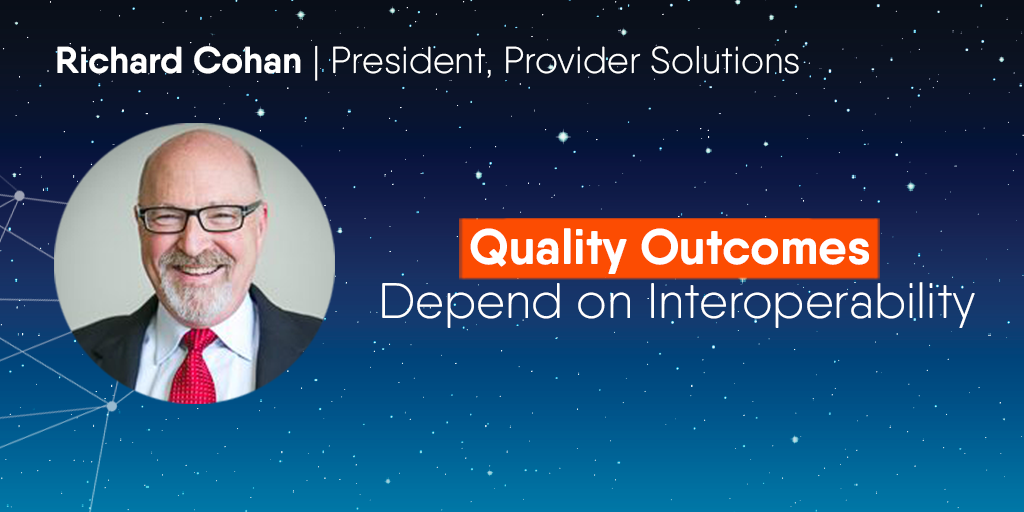Richard Cohan
Quality Outcomes Depend on Interoperability
In 2007, the Institute for Healthcare Improvement (IHI) introduced the Triple Aim as a framework to help healthcare organizations raise patient care standards in the United States. The model includes enhancing the patient experience of care, improving the health of populations, and reducing the per capita cost of care. While a fourth metric – clinical staff satisfaction – has been added recently to address rampant burnout among clinicians, realizing the objectives of the now Quadruple Aim continues to be a struggle, largely attributed to the lack of interoperability.
Traditionally, payers tried to use restrictive tools such as prior authorizations to control cost, largely because few other options were available. Payers had no real way to get information to the point of care to inform clinicians as to what, in their view, were optimal treatment protocols, or best modes of care.
We need performance-based care that drives better outcomes by providing doctors with actionable information without interruptions and without adding friction in their provision of care to patients.
Healthcare change is notorious for moving at a glacial pace, at least technologically. But realizing the true promise of value-based care is only going to happen once we solve these interoperability issues to align with new payer requirements and give providers point-of-care resources that don’t exist today within the electronic health record (EHR).
Complexity is a Challenge
As reimbursement models and technology have evolved, healthcare has become infinitely more complex and more performance-focused, adding a huge administrative burden to providers that is contributing to burnout. Payers, pharmacy benefit managers (PBMs), health systems, and pharmacies each have their own back-end technologies that require clinicians to log into multiple portals to access time-limited information. None of these technologies capture a patient’s holistic health history envisioned by all stakeholders.
The introduction of EHRs, accelerated by the introduction of Meaningful Use in 2009 brought great hope for the easy exchange and portability of patient information. But with more than 700 EHRs on the market, and no real way for them to “talk” to each other or to payer systems, true interoperability – in real-time and at minimal or no cost to clinicians – remained out of reach.
Throughout this evolution, patients and providers have been dismayed as more focus has been dedicated to process efficiency than to patient centricity and to quantity over quality. It’s no wonder then, that payers face the unintended consequences of network dissatisfaction and member churn. In fact, health plan members shop for new coverage based on benefits and provider access every three to four years, on average, leaving their health histories behind and frustrating their physicians.
A New Era of Quality and Information Portability
Historically, all patient data has belonged to the insurance company. The new Interoperability and Patient Access Rule from the Centers for Medicare and Medicaid Services (CMS) changes that by directing that patients own their health information. Going forward, patients’ health histories should move with them and be available for their next provider. And a doctor shouldn’t have to jump through hoops or log into multiple portals to learn about a new patient. But this is only possible if medical and medication histories can be exchanged between payers and healthcare systems through EHRs.
Fortunately, technological advances are helping bridge interoperability gaps. For instance, Fast Healthcare Interoperability Resource (FHIR) data exchanges and APIs are enabling interactions with legacy technology systems. Payers’ back-end operations now can be accessed securely to allow data to be pulled, pooled, and/or delivered into EHRs for better collaboration.
Today’s capabilities look beyond yesterday’s administrative goals, which exclusively dealt with claims, eligibility, and adjudications systems, to focus on clinical pathways to better health. But still, there are gaps.
Bridging the Gaps
Pioneering healthcare technology companies like DrFirst are deploying new solutions that break through data silos and enhance the utility of EHRs with real-time health histories and member-specific benefit information. We’re providing this information to practitioners in an intuitive, non-intrusive, actionable way, at the point of care, or soon after the patient is engaged in a healthcare episode and is really thinking about their care.
Putting current benefits and medical information at clinicians’ fingertips takes finesse. It must be done in a manner that helps complete the diagnostic puzzle rather than distract from it or overwhelm. A complete patient health history can relieve the frustration doctors feel when they or their staff have to chase down updated results rendered elsewhere, waste precious minutes on hold securing a prior authorization, or wonder with their patient how much a lab test or drug might cost out of pocket.
To fill information gaps, DrFirst aggregates a longitudinal view of the patient that includes medical and medication histories, benefits information, lab and imaging costs, and in-network referral options. We deliver specific insights to clinicians within their clinical workflow and at just the right time.
In this connected environment, a provider can identify less expensive therapies, diagnostic centers with the best outcomes at lower costs, and other valuable information to help remove barriers. Providers are better equipped to engage their patients in care decisions and can work together to plan the most affordable and therapeutically appropriate course of care. And, when patients can afford and understand care decisions, they are more likely to adhere to their treatment plans and achieve their best health.
Making actionable data available in a frictionless manner during a patient appointment illustrates the true value of interoperability and drives better care for patients, more sustainable healthcare businesses, more satisfied clinicians, and, ideally, better community health in the long run.
And that is how you achieve the Quadruple Aim.


















